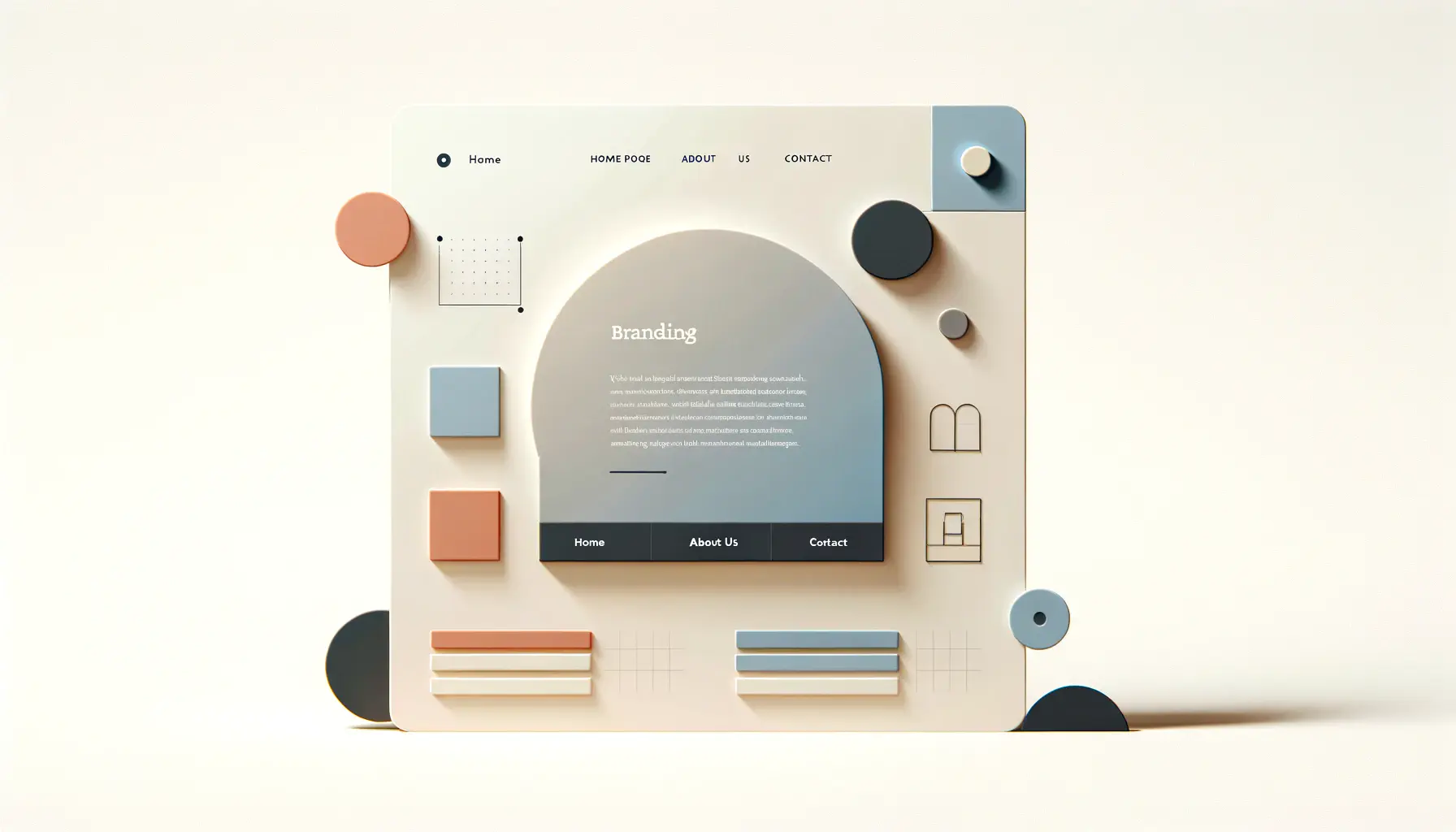The digital landscape is evolving rapidly, and with it, the strategies businesses use to engage their audience.
At the heart of this evolution is content strategy, a discipline that has become indispensable in the realm of web design branding.
Content, in its essence, is the vehicle through which brands communicate their identity, values, and offerings to their audience.
It’s not just about what you say, but how you say it, making content strategy a critical component of web design branding.
Understanding the role of content strategy in web design branding requires a deep dive into the intricacies of digital communication.
It’s a multifaceted process that involves not just the creation of engaging content but also its organization, delivery, and governance across digital platforms.
This process ensures that a brand’s message is not only heard but also resonates with its intended audience, fostering a connection that is both meaningful and lasting.
- Foundations of Content Strategy in Branding
- Strategic Content Creation and Curation
- Optimizing Content for Search Engines
- Engaging the Audience Through Social Media
- Utilizing Analytics to Refine Content Strategy
- Integrating Multimedia Elements in Content Strategy
- Building Community Through Content
- Conclusion: Elevating Web Design Branding Through Content Strategy
- FAQs on Content Strategy in Web Design Branding
Foundations of Content Strategy in Branding
At the core of any successful web design branding effort lies a well-thought-out content strategy.
This strategy serves as the blueprint for creating, managing, and optimizing content that aligns with a brand’s goals and audience’s needs.
It’s about crafting stories that engage, inform, and inspire action, all while maintaining a cohesive brand voice and identity.
Content strategy in web design branding goes beyond mere content creation.
It involves a thorough analysis of the target audience, including their preferences, behaviors, and pain points.
This analysis informs the content’s tone, style, and format, ensuring that each piece of content not only captures the audience’s attention but also drives them towards a desired action, be it a subscription, purchase, or engagement.
Key Components of a Content Strategy
A robust content strategy encompasses several key components, each playing a vital role in the success of web design branding.
These components include content audit and analysis, which help identify gaps and opportunities in existing content.
Content governance policies ensure consistency and quality across all brand communications.
Meanwhile, content creation and curation are about producing and gathering content that adds value to the audience’s experience.
Another critical component is content distribution, which involves choosing the right channels and formats to reach the audience effectively.
Lastly, content performance measurement allows brands to track the success of their content strategy, providing insights that can inform future content initiatives.
A successful content strategy is the backbone of effective web design branding, ensuring that a brand’s message is not only seen but also felt by its audience.
In conclusion, the role of content strategy in web design branding cannot be overstated.
It’s a comprehensive approach that ensures a brand’s message is consistently communicated across all digital touchpoints.
By focusing on the needs and preferences of the target audience, content strategy enables brands to build a strong online presence, foster customer loyalty, and ultimately, achieve their business objectives.
Strategic Content Creation and Curation
Creating and curating content with strategic intent is pivotal in web design branding.
This process involves not just generating original content but also selecting existing external content that can be repurposed or highlighted within a brand’s digital ecosystem.
The goal is to provide a rich, engaging user experience that reflects the brand’s identity and values, while also meeting the audience’s needs and interests.
Strategic content creation and curation require a deep understanding of the brand’s target audience.
This includes knowing their preferences, challenges, and how they consume content online.
With this knowledge, brands can create content that resonates on a personal level, driving engagement and fostering a strong brand connection.
Content Creation Techniques
- Storytelling: Crafting narratives that connect with the audience on an emotional level, making the brand more relatable and memorable.
- Visual Content: Utilizing images, videos, and infographics to capture attention and convey messages more effectively than text alone.
- Interactive Content: Creating quizzes, polls, and interactive infographics that encourage user participation and increase engagement.
- Educational Content: Providing valuable information that addresses the audience’s questions or challenges, positioning the brand as a thought leader in its industry.
Content Curation Strategies
- Industry News: Sharing relevant news articles or studies to keep the audience informed about the latest trends and developments.
- User-generated Content: Featuring content created by the audience, such as reviews or social media posts, to build community and trust.
- Influencer Collaborations: Partnering with influencers to share their insights or experiences related to the brand, reaching a wider audience.
- Resource Lists: Compiling lists of tools, tips, or resources that the audience may find useful, adding value to their experience.
Incorporating a mix of original and curated content allows brands to maintain a fresh and diverse content library that appeals to different segments of their audience.
Effective content strategy in web design branding is not just about what content is created but also how it is presented and shared.
Strategic content creation and curation are essential for engaging the audience, building brand loyalty, and differentiating the brand in a crowded digital landscape.
Optimizing Content for Search Engines
Optimizing content for search engines is a critical aspect of content strategy in web design branding.
SEO (Search Engine Optimization) ensures that a brand’s content is discoverable by the target audience when they search for relevant topics or keywords.
This process involves a combination of techniques and practices designed to improve a website’s visibility in search engine results pages (SERPs), driving organic traffic and enhancing brand awareness.
SEO is not just about incorporating keywords into content; it’s about creating valuable, high-quality content that answers the audience’s questions and meets their needs.
By aligning content with search intent, brands can improve their search rankings, attract more visitors, and ultimately, convert them into customers or followers.
Key SEO Practices for Content Strategy
- Keyword Research: Identifying the terms and phrases that the target audience uses to search for information online. This involves analyzing search volume, competition, and relevance to the brand’s offerings.
- Content Optimization: Incorporating keywords naturally into titles, headings, meta descriptions, and throughout the content body. It’s crucial to maintain readability and avoid keyword stuffing.
- Quality Content: Producing content that is informative, engaging, and valuable to the audience. High-quality content is more likely to be shared and linked to, which can improve search rankings.
- Mobile Optimization: Ensuring that content is accessible and performs well on mobile devices, as mobile-friendliness is a significant ranking factor for search engines.
- Page Speed: Optimizing images and minimizing code to improve page loading times, as faster websites provide a better user experience and are favored by search engines.
Measuring SEO Success
Tracking and analyzing the performance of SEO efforts is essential for understanding the impact of content strategy on search visibility and traffic.
Key metrics to monitor include organic search traffic, keyword rankings, click-through rates (CTR), and conversion rates.
By regularly reviewing these metrics, brands can identify areas for improvement and adjust their content strategy accordingly.
SEO is an ongoing process that requires continuous optimization and adaptation to changes in search engine algorithms and audience behavior.
In conclusion, optimizing content for search engines is a fundamental component of content strategy in web design branding.
By focusing on SEO, brands can improve their online visibility, attract more targeted traffic, and establish themselves as authoritative sources in their industry.
Engaging the Audience Through Social Media
Social media platforms offer a unique opportunity for brands to engage directly with their audience, making it a crucial element of content strategy in web design branding.
By leveraging social media, brands can extend the reach of their content, foster community, and drive engagement in a way that’s both personal and scalable.
The key to success on social media lies in understanding the nuances of each platform and creating content that resonates with the audience’s preferences and behaviors on those channels.
Effective social media engagement goes beyond posting regular updates; it involves creating a dialogue with the audience, listening to their feedback, and providing value through informative, entertaining, or inspiring content.
This approach not only enhances brand visibility but also builds trust and loyalty among followers.
Strategies for Social Media Engagement
- Platform-Specific Content: Tailoring content to fit the format and culture of each social media platform, whether it’s short-form videos for TikTok, professional articles for LinkedIn, or visually appealing posts for Instagram.
- Interactive Content: Encouraging participation through polls, quizzes, contests, and user-generated content campaigns to increase engagement and create a sense of community.
- Consistent Posting Schedule: Maintaining a regular posting schedule to keep the audience engaged and informed, while also taking advantage of peak engagement times for each platform.
- Responsive Engagement: Actively responding to comments, messages, and mentions to foster a two-way conversation and show that the brand values its audience’s input and participation.
- Value-Driven Content: Sharing content that provides real value to the audience, whether through tips, insights, industry news, or behind-the-scenes looks, to establish the brand as a go-to resource.
Leveraging Analytics for Social Media Success
Measuring the impact of social media efforts is essential for refining strategy and maximizing engagement.
Social media analytics tools can provide valuable insights into follower demographics, engagement rates, content performance, and more.
By analyzing this data, brands can identify what types of content resonate most with their audience, the best times to post, and areas for improvement in their social media strategy.
Social media is not just a broadcasting channel; it’s a platform for building relationships with your audience through meaningful interactions and engaging content.
Incorporating social media into the content strategy of web design branding allows brands to connect with their audience on a more personal level, enhancing brand awareness and loyalty.
By engaging the audience through carefully crafted, platform-specific content and interactive elements, brands can create a dynamic online presence that supports their overall branding and marketing goals.
Utilizing Analytics to Refine Content Strategy
The digital landscape is rich with data, offering brands unprecedented insights into their audience’s behavior and content performance.
Utilizing analytics is essential for refining a content strategy in web design branding, enabling brands to make informed decisions that enhance user engagement and achieve business objectives.
By analyzing data, brands can identify what works, what doesn’t, and where there are opportunities for optimization.
Analytics provide a window into the audience’s preferences, how they interact with content, and the pathways they take through a website.
This information is invaluable for tailoring content strategy to meet user needs more effectively and for optimizing the user journey to encourage desired actions, such as conversions, sign-ups, or downloads.
Key Metrics for Content Strategy Optimization
- User Engagement: Metrics such as page views, time on page, and bounce rate offer insights into how engaging the content is and whether it meets the audience’s expectations.
- Conversion Rates: Tracking conversions from specific pieces of content helps identify what drives users to take action and what content types are most effective at achieving business goals.
- Traffic Sources: Understanding where traffic comes from (e.g., organic search, social media, direct) can inform content distribution strategies and highlight the most valuable channels for reaching the audience.
- Content Reach: Analyzing which content pieces have the widest reach and why can help in crafting future content that has the potential to attract a larger audience.
- Audience Demographics: Data on the audience’s age, gender, location, and interests can guide content personalization efforts, making content more relevant and engaging to different segments.
Implementing Changes Based on Analytics
Armed with data, brands can implement targeted changes to their content strategy.
This might involve adjusting the content mix to include more of what resonates with the audience, optimizing existing content for better performance, or reevaluating distribution channels to maximize reach and engagement.
Continuous testing and iteration are key, as what works today may not work tomorrow in the ever-evolving digital landscape.
Analytics are not just numbers; they tell a story about your audience’s preferences and behavior, offering actionable insights for strategic content optimization.
In conclusion, utilizing analytics is a critical practice for refining content strategy in web design branding.
By leveraging data to understand the audience better and measure content performance, brands can continuously improve their content offerings, enhance user engagement, and more effectively achieve their marketing and business objectives.
Integrating Multimedia Elements in Content Strategy
In today’s digital age, integrating multimedia elements into a content strategy is essential for capturing and maintaining the audience’s attention.
Multimedia, including images, videos, infographics, and interactive elements, enriches the user experience by providing varied and engaging ways to consume content.
This diversity not only enhances the aesthetic appeal of a website but also supports deeper engagement and comprehension of the brand’s message.
Effective use of multimedia in web design branding involves more than just adding visuals to content; it requires a strategic approach that aligns with the brand’s goals and audience’s preferences.
By carefully selecting and incorporating multimedia elements, brands can create a more immersive and interactive experience that resonates with users and encourages them to engage with the content on a deeper level.
Benefits of Multimedia in Content Strategy
- Increased Engagement: Multimedia elements like videos and interactive infographics can capture the audience’s attention more effectively than text alone, leading to higher engagement rates.
- Improved Understanding: Visual aids and interactive elements can help explain complex concepts more clearly, improving the audience’s understanding and retention of information.
- Enhanced SEO: Including multimedia can improve a website’s SEO by increasing time on site and providing additional opportunities for keyword optimization through alt tags and video transcripts.
- Greater Shareability: Visually appealing or interactive content is more likely to be shared on social media, increasing the brand’s reach and visibility.
Strategies for Multimedia Integration
- Align with Content Goals: Choose multimedia elements that support the content’s objectives, whether it’s to inform, entertain, or inspire action.
- Consider User Experience: Ensure multimedia elements are optimized for fast loading and are accessible across devices, maintaining a positive user experience.
- Encourage Interaction: Use interactive elements like quizzes or polls to engage users actively, making the content experience more dynamic and personalized.
- Measure and Optimize: Track the performance of multimedia content to understand its impact on engagement and conversions, and optimize based on insights.
Multimedia is not just an embellishment; it’s a powerful tool for storytelling and engagement in content strategy, offering diverse ways to connect with and captivate the audience.
Integrating multimedia elements into a content strategy enhances the overall impact of web design branding.
By leveraging the power of visuals, videos, and interactive content, brands can create a more compelling and memorable online presence that effectively communicates their message and engages their target audience.
Building Community Through Content
One of the most impactful strategies in web design branding is leveraging content to build a community around a brand.
A strong community not only fosters loyalty and advocacy but also provides valuable feedback and insights that can guide future content and product development.
Content that encourages interaction, discussion, and sharing can transform passive viewers into active participants and brand ambassadors.
Building a community through content requires a focus on creating spaces for engagement and dialogue, both on the brand’s platforms and across social media.
By prioritizing content that resonates on a personal level, brands can encourage users to connect with each other and with the brand, creating a sense of belonging and shared purpose.
Strategies for Community-Building Content
- Create Value-Driven Content: Share content that provides real value to your audience, such as how-to guides, tips, and insights, encouraging users to engage and share their experiences.
- Encourage User-Generated Content: Invite your community to contribute their own content, whether through comments, stories, photos, or videos, fostering a sense of ownership and involvement.
- Host Q&A Sessions and Webinars: Engage directly with your audience through live sessions, answering their questions and discussing topics of interest, to build rapport and trust.
- Highlight Community Stories: Share stories, testimonials, or case studies from within your community, showcasing real-life applications of your brand and how it impacts users’ lives.
Leveraging Content Platforms for Community Engagement
Choosing the right platforms is crucial for community-building efforts.
While your website should serve as a central hub for content, social media platforms offer additional opportunities for interaction and engagement.
Blogs, forums, and dedicated community spaces on your website can also provide a platform for deeper discussions and connections among users.
Each platform offers unique features that can be leveraged to foster community engagement, from comment sections on blogs to groups and hashtags on social media.
A vibrant community not only supports brand loyalty but also turns customers into brand advocates, amplifying your message through their networks.
In conclusion, building a community through content is a powerful strategy in web design branding.
By creating and curating content that encourages engagement, dialogue, and sharing, brands can cultivate a loyal community that supports and amplifies their brand message.
This approach not only enhances brand visibility but also provides valuable insights and feedback that can inform future strategies.
Conclusion: Elevating Web Design Branding Through Content Strategy
The journey through the multifaceted landscape of content strategy in web design branding reveals a compelling narrative: content is not merely a component of digital strategy; it is the heartbeat of engaging, memorable, and effective online branding.
As we’ve explored, the integration of strategic content creation, SEO optimization, social media engagement, analytics, multimedia elements, and community building forms a cohesive blueprint for brands aiming to resonate deeply with their audience.
Key Takeaways for a Robust Content Strategy
In synthesizing the insights from our exploration, several key takeaways emerge, each serving as a pillar for constructing a content strategy that not only speaks to the audience but also amplifies a brand’s digital presence:
- Strategic content creation and curation are foundational, enabling brands to tell their story in a way that connects and converts.
- SEO optimization ensures that this story reaches its intended audience through the clutter of digital noise, making discoverability a priority.
- Social media engagement transforms brands from monologues into dialogues, fostering relationships and loyalty.
- Utilizing analytics allows brands to refine and adapt their strategy, ensuring content remains relevant and impactful.
- Integrating multimedia enriches the narrative, catering to diverse preferences and enhancing engagement.
- Building a community around content creates a shared space for interaction, feedback, and advocacy, strengthening the brand’s impact.
Forging Ahead: The Future of Content Strategy in Branding
As we look to the future, the role of content strategy in web design branding is poised to become even more critical.
In an ever-evolving digital landscape, the ability to adapt, innovate, and engage through content will distinguish successful brands from the rest.
The future of content strategy lies in its ability to seamlessly blend with emerging technologies, personalize experiences at scale, and foster genuine connections through storytelling.
For brands willing to invest in a comprehensive content strategy, the rewards extend beyond visibility and traffic.
A well-executed content strategy cultivates a brand’s identity, nurtures a loyal community, and ultimately, drives sustainable growth.
As we move forward, the fusion of creativity, analytics, and strategic thinking will define the next horizon of web design branding, with content strategy leading the charge.
In conclusion, the essence of content strategy in web design branding lies not just in creating content but in crafting experiences, emotions, and engagements that resonate on a human level.
It’s about weaving a brand’s narrative into the fabric of the digital experience, ensuring that every interaction reflects the brand’s values, vision, and voice.
As brands navigate the complexities of the digital world, a robust content strategy will be their compass, guiding them towards meaningful connections and enduring success.
Quality web design is key for a great website! Check out our service page to partner with an expert web design agency.
FAQs on Content Strategy in Web Design Branding
Explore common questions about integrating content strategy into web design branding to enhance your online presence effectively.
Content strategy in web design branding involves planning, creating, and managing web content to align with a brand’s goals and meet user expectations.
Content strategy enhances SEO by ensuring content is relevant, valuable, and optimized for keywords, improving search engine rankings and visibility.
Teamwork ensures a cohesive approach, integrating expertise from design, UX, SEO, and copywriting to create a unified and effective content strategy.
Content marketing focuses on creating valuable content for users, while SEO optimizes content to rank higher in search engine results.
Identify your audience, define clear goals, create valuable and relevant content, and continuously measure and adjust your strategy based on analytics.
Multimedia enriches content, enhances user engagement, and supports better understanding of the brand’s message through diverse formats.
Success is measured by analyzing engagement metrics, conversion rates, SEO performance, and overall alignment with brand objectives.
Yes, a well-executed content strategy increases brand visibility, engages the target audience, and builds a recognizable online brand identity.











